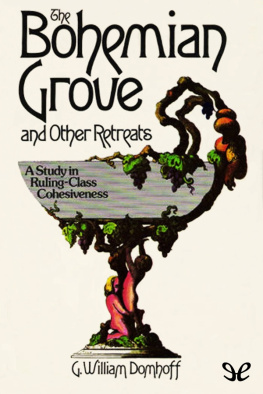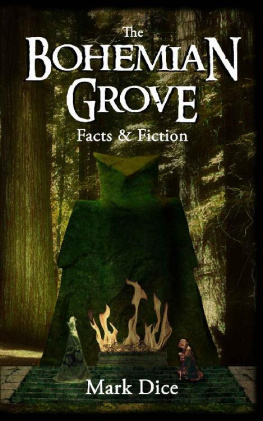The Bohemian Grove and Other Retreats: A Study in Ruling-Class Cohesiveness, published in 1974 by psychologist and sociologist G. William Domhoff, is a fascinating study of several important retreats frequented by elite businessmen, politicians, scientists, artists, and other members of the upper-class elite.
These retreats and in particular the Bohemian Grove retreat are infamous for the bizarre rituals which take place during the time spent there and for the often scandalous behavior of otherwise conservative businessmen that allegedly takes place there. It has been further maintained by some that during these retreats important policy decisions are embarked upon and indeed it is this fact that makes such retreats so notorious given the fact that what goes on there is not covered by the press. While the Bohemian Grove has for a motto Weaving Spiders Come Not Here and includes a bizarre ritual called the Cremation of Care in which a body symbolizing the cares of the world is cremated thus serving to remind the businessmen that they are not to engage in politicking while on the retreat, it has nevertheless been maintained that such retreats offer a socially cementing process whereby the elite become unified as a class.
Such cohesiveness may ultimately serve to underpin policy decisions which have effects on the United States (and indeed the rest of the world) that serve the interests of the upper-class elite. Domhoff presents the essential thesis that such retreats (while frivolous affairs on the face of it) actually serve a deeper purpose in unifying the upper-class elite which in turn is reflected in the policy decisions of important political figures. Further, Domhoff will controversially maintain that this upper-class is really a ruling-class against the pluralist belief that various groups come together to make policy. However, whatever one thinks of Domhoffs ultimate thesis concerning the ruling-class, there is some fascinating and bizarre information to be found in this book concerning the goings-on at certain upper-class retreats (and in particular at Bohemian Grove).
In recent times, certain conspiracy theorists have become fascinated with the events and bizarre rituals that go on at Bohemian Grove and have maintained that such rituals are linked to ancient cults, Satanism, etc. Whatever one thinks of these conspiracy theories however, the rituals and events of Bohemian Grove are certainly very strange indeed and ultimately serve to cement the social structures of the upper-classes.

G. William Domhoff
The Bohemian Grove and Other Retreats
A Study in Ruling-Class Cohesiveness
ePub r1.0
RLull 19.04.16
Ttulo original: The Bohemian Grove and Other Retreats
G. William Domhoff, 1974
Editor digital: RLull
ePub base r1.2

To Lynne, Lori, Bill, and Joel
Notas
[1] Charles K. Field, The Cremation of Care (1946, 1953), for these and following quotes. A copy of this small pamphlet can be found in the Bancroft Library, University of California, Berkeley.
[2] Robert H. Fletcher, The Annals of the Bohemian Club (San Francisco: Hicks-Judd Company, 1900), Vol. I, 1872-80, p. 34.
[3] Harold L. Ickes, The Secret Diary of Harold L. I First Thousand Days, 1933-36. (New York: Simon and pp. 178-79. I am grateful to my friend and colleagu W. Baer, for calling this passage to my attention.
[4] Richard J. Whalen, Catch the Falling Flag: A Republicans Challenge to His Party (Boston: Houghton Mifflin, 1972), p. 25. Earlier in this book, on page 4, Whalen reports that his own speech in 1969 at the Bohemian Grove, which concerned the U.S.-Soviet nuclear balance, was distributed by President Nixon to cabinet members and other administration officials with a presidential memorandum commending it as an excellent analysis. I am grateful to sociologist Richard Hamilton of McGill University for bringing this material to my attention.
[5] Wallace Turner, Rockefeller Faces Scrutiny of Top Califomians: Governor to Spend Weekend at Bohemian Grove among States Establishment (New York Times, July 26, 1963), p. 30. In 1964 Senator Barry Goldwater appeared at the Grove as a guest of retired General Albert C. Wedemeyer and Herbert Hoover, Jr. For that story see Wallace Turner, Goldwater Spending Weekend in Camp at Bohemian Grove (New York Times, July 31, 1964), p. 10.
[6] James M. Naughton, Nixon Drops Plan for Coast Speech (New York Times, July 31, 1971), p. 11.
[7] There is a special moisture-proof building at the Grove to hold the dozens of expensive Steinway pianos belonging to the club and various camps.
[8] And for sale. Painters in particular earn a considerable amount of money through the Bohemian Club. But that is getting ahead of the story.
[9] Paul Avery, Mistrial Ordered in Russian River Case (San Francisco Chronicle, March 15, 1972), p. 3.
[10] Herb Caen, The Morning Line (San Francisco Chronicle, July 25, 1972), p. 17.
[11] For further discussion of these problems, and a list of social indicators, see G. William Domhoff, Who Rules America? (Englewood Cliffs, N.J.: Prentice-Hall, 1967), Chapter 1, and G. William Domhoff, The Higher Circles (New York: Random House, 1970), Chapter 1.
[12] G. William Domhoff, Fat Cats and Democrats (Englewood Cliffs, N.J.: Prentice-Hall, 1972), pp. 61-62.
[13] Herbert E. Alexander, Money in Politics (Washington, D.C.: Public Affairs Press, 1972), Chapter 9, for summary and references.
[14] Sterling has been a very active member. For many years he was in charge of Preachers' SonsNight, when the sons of ministers are supposed to give speeches and provide entertainment.
[15] Gary Wills, Nixon Agonistes (Boston: Houghton Mifflin, 1970), p. 256.
[16]Bohemian Club, San Francisco, 1969, p. 24. This is the handbook for individual members, containing officers and directors, constitution, bylaws, house rules, a list of deceased members, and a brief history of the club.
[17]Report of the President and the Treasurer, 1969-70, p. 23. This document is available at the California Historical Society in San Francisco.
[18]Bohemian Club (San Francisco, 1969), p. 27.
[19] Wallace Turner, Rockefeller Faces Scrutiny of Top Californians: Governor to Spend Weekend at Bohemian Grove among States Establishment (New York Times, July 26, 1963), p. 30.
[20] Fletcher, The Annals of the Bohemian Club, Vol. I, pp. 26-27.
[21] Richard OConnor, Jack London: A Biography (Boston: Little, Brown, 1964), p. 151. London liked the Grove very much and seldom missed an encampment.
[22] Edward Bosqui, Memoirs of Edward Bosqui (Oakland: Holmes Book Company, 1952), pp. 126-127.
[23] Albert Parry, Garrets and Pretenders: A History of Bohemianism in America (New York: Dover Publications, 1933, 1960), p. 226.
[24]Early Bohemia (no author, no date), pp. 4-5. This small, privately printed book is available in the California Historical Society in San Francisco.
[25] Jerome A. Hart, Tavernier, Artiste-Peintre, March 2, 1907. In Oversized San Francisco Miscellaneous, Bohemian Club, California Historical Society, San Francisco.
[26] Parry, Garrets and Pretenders














